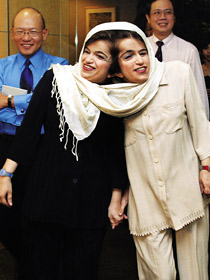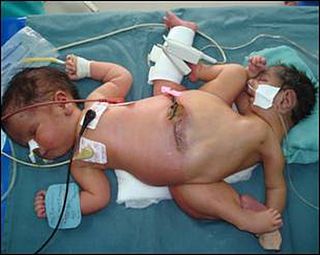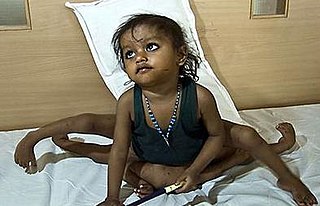Related Research Articles

Conjoined twins, popularly referred to as Siamese twins, are twins joined in utero. It is a very rare phenomenon, estimated to occur in anywhere between one in 49,000 births to one in 189,000 births, with a somewhat higher incidence in Southwest Asia and Africa. Approximately half are stillborn, and an additional one-third die within 24 hours. Most live births are female, with a ratio of 3:1.

Ladan and Laleh Bijani were Iranian conjoined twin sisters. They were joined at the head and died soon after their complicated surgical separation.

Daisy and Violet Hilton were English-born entertainers who were conjoined twins. They were exhibited in Europe as children, and toured the United States sideshow, vaudeville and American burlesque circuits in the 1920s and 1930s. They were best known for their film appearances in Freaks and the biographic Chained for Life (1951).
Abigail Loraine Hensel and Brittany Lee Hensel are American conjoined twins. They are dicephalic parapagus twins, and are highly symmetric for conjoined twins. Each has a heart, stomach, spine, pair of lungs, and spinal cord. Each twin controls one arm and one leg. When they were infants, learning to crawl, walk, and clap required cooperation. They can eat and write separately and simultaneously. Activities such as running, swimming, hair-brushing, playing piano or volleyball, riding a bicycle, or driving a car require coordination.

Sirenomelia, also called mermaid syndrome, is a rare congenital deformity in which the legs are fused together, giving the appearance of a mermaid's tail, hence the nickname.

Ischiopagi comes from the Greek word ischio- meaning hip (ilium) and -pagus meaning fixed or united. It is the medical term used for conjoined twins who are united at the pelvis. The twins are classically joined with the vertebral axis at 180°. The conjoined twins usually have four arms; two, three or four legs; and typically one external genitalia and anus.
Clarence and Carl Aguirre are former conjoined twins born in Manila. They were conjoined at the top of the head and shared 8 centimetres (3.1 in) of brain. More than 1–2 centimetres (0.4–0.8 in) will affect brain functionality in one or both of twins. Without separation, they were expected to live around 6–8 months.

Polycephaly is the condition of having more than one head. The term is derived from the Greek stems poly meaning "many" and kephalē meaning "head". A polycephalic organism may be thought of as one being with a supernumerary body part, or as two or more beings with a shared body.
Krista and Tatiana Hogan are Canadians who are conjoined craniopagus twins. They are joined at the head and share a skull and a brain. They were born in Vancouver, British Columbia, and are the only unseparated conjoined twins of that type currently alive in Canada. They live with their mother, Felicia Simms, in Vernon, British Columbia, have two sisters and a brother and often travel to Vancouver for care at BC Children's Hospital and Sunny Hill Health Centre for Children.
Anastasia and Tatiana Dogaru are craniopagus conjoined twins. They were scheduled to begin the first of several surgeries to separate them at Rainbow Babies and Children's Medical Center in Cleveland, Ohio. However, in August 2007 the surgery was called off as too dangerous.

Yarlagadda Nayudamma is a consultant paediatric surgeon from Guntur, India. Previously, he operated at the Guntur General Hospital where he was the head of the paediatric surgery department.

Lakshmi Tatma is an Indian girl born in 2005 in a village in Araria district, Bihar, with four arms and four legs. She was actually one of a pair of ischiopagus conjoined twins, one of which was headless because its head had atrophied and chest had not fully developed in the womb, causing the appearance of one child with four arms and four legs. She has undergone surgery to remove these extra limbs.

Viet Nguyen and Duc Nguyen were a pair of Vietnamese conjoined twins surgically separated in 1988. Viet died in 2007 of natural causes.

Dicephalic parapagus is a rare form of partial twinning with two heads side by side on one torso. Infants conjoined this way are sometimes called "two-headed babies" in popular media. The condition is also called parapagus dicephalus.
Wirginia June Maixner is an Australian neurosurgeon and the director of neurosurgery at the Royal Children's Hospital in Melbourne, Australia. She is known for having performed the first auditory brainstem implant on a child in Australia in 2007, and later having separated the conjoined twins, Trishna and Krishna in 2009.
Rudy Santos, also known by his stage name Octoman, is a Filipino with a rare condition known as parasitic twin. He is the oldest person ever recorded with this condition.
Craniopagus twins are conjoined twins who are fused at the cranium. The union may occur on any portion of the cranium, but does not primarily involve either the face or the foramen magnum; the two brains are usually separate, but they may share some brain tissue. Conjoined twins are genetically identical and always share the same sex. The thorax and abdomen are separate and each twin has their own umbilicus and umbilical cord.
Ganga and Jamuna Mondal, known professionally as The Spider Girls and The Spider Sisters, are conjoined twins from a Bengali family in Basirhat, West Bengal, India.
Maria and Teresa Tapia are formerly conjoined twins born in the Dominican Republic. The twins were joined by their lower chest and abdomen and were therefore classified as omphalopagus, sharing a liver, pancreas, and a small portion of their small intestine. On November 7, 2011, the twins underwent successful separation surgery at the Children's Hospital of Richmond in Virginia.
Muhimbili National Hospital is a 1500-bed public teaching hospital located in Upanga West ward of Ilala District in Dar es Salaam Region of Tanzania. It is the national referral hospital as well as academic and research facility for the Muhimbili University of Health and Allied Sciences. It offers speciality care across the spectrum of clinical medicine. About 40% of its beds are for private patients. The hospital employs around 2705 workers including 328 doctors and 946 nurses.
References
- 1 2 3 4 5 Herrin, Jake (2007). "Herrin Twins". herrintwins.com. Archived from the original on June 6, 2014. Retrieved April 16, 2007.
- ↑ "Sisters Who Share Kidney Undergoing Separation". Health News. 2006-08-07.
- ↑ "Maliyah Herrin Doing Well in Recovery From Transplant". KSL News Radio. 2007-04-16.
- ↑ I GOT A KIDNEY TRANSPLANT! | Herrin Twins. YouTube . Archived from the original on 2021-12-09.